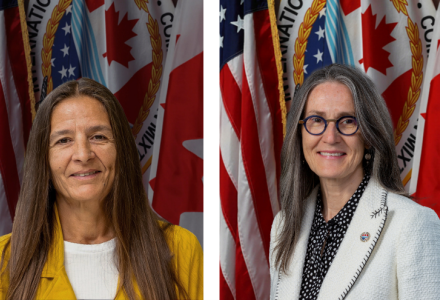
Since the International Watersheds Initiative (IWI) started 25 years ago, the IJC has looked for new approaches to applying its principles. These include cross-border collaboration involving local experts, the public and Indigenous Nations, approaching watersheds as whole ecosystems not confined by political boundaries and reassessing management decisions to reflect climate change. These principles come alive in several “big picture” efforts under the IWI umbrella across the Canada-United States transboundary region.
Aligning Different Geospatial Datasets from Canada and the United States
Both Canada and the U.S. collect and develop water-related information and datasets for their respective watersheds.
Their approaches and standards for data collection can differ, however, and this poses special challenges for those watersheds shared between both countries. Prior to an IWI project, water managers, scientists and land use planners were stuck working with incomplete information or data that didn’t line up between countries.
In 2008, the IJC formed a special task force under IWI to harmonize geospatial datasets between the two countries. Over the following decade, members of this task force—comprised of experts from Canadian and US agencies, universities, other organizations and IJC staff—zeroed in on “the swath,” the specific drainage areas of these watersheds that span the border. Through a pair of working groups, task force members worked to align the disparate geospatial data from Canada and the U.S. within the swath, providing a complete and continuous picture of watersheds in these regions.

A Rainy River basin water dataset before-and-after harmonization. The image on the left features the original, separate datasets from Canada and the U.S., while the right features the harmonized data. Credit: IJC
The harmonized data is publicly available through the US Geological Survey (USGS) and Natural Resources Canada. The IJC, USGS and Natural Resources Canada continue to collaborate and assess the need for additional updates to harmonized watershed datasets as tools and monitoring approaches in both Canada and the U.S. change over time.
The Song of a SPARROW: Using Harmonized Data to Understand Nutrient Loading to Rivers and Lakes
Building on the example of the data harmonization task force, the IWI supported development of a watershed model to address the expanding growth and frequency of algal blooms in transboundary water systems. This model connects patterns in water quality to both natural and human activities, providing detailed insight into the causes and effects of specific issues, such as nutrients like phosphorus and nitrogen entering waterways. Since these are shared watersheds where nutrients can travel across international boundaries, this modeling project also fulfills the IWI goal of helping prevent and resolve transboundary issues.
Known as SPARROW (Spatially Referenced Regression on Watershed attributes), this model was originally developed by USGS and used on portions of the Red-Assiniboine River basin through partnerships with National Research Council Canada, and Environment and Climate Change Canada. Thanks to the creation of harmonized datasets, it was now possible to extend the model north into the Canadian portion of the basin. This project got underway in 2011 and was completed in 2015. SPARROW was then used in the Great Lakes basin as part of ongoing efforts to clean up nutrient pollution, notably in Lake Erie, where an Adaptive Management Plan developed by Environment and Climate Change Canada and the US Environmental Protection Agency makes use of the model’s results.

A SPARROW map of the Red and Assiniboine River basins. Credit: IJC
Planning for the Future with Climate Change
Due to climate change, it is becoming more difficult for water managers and IJC boards to rely on past records to predict conditions on transboundary lakes and rivers. To help boards prepare and plan accordingly, the IWI has supported IJC boards to assess the potential impacts of climate change in their basins.
Using tools such as climate models can help boards assess potential impacts to their specific responsibilities, determine how future changes in the climate may impact the work that board does, and possible changes to ensure it can still carry out its mission.
This is known as the “Climate Change Guidance Framework,” and was first implemented by the International St. Croix River Watershed Board in 2017. At that time, the board found that the region in general will become warmer and wetter, potentially exacerbating water quality issues and both wet and dry conditions. The board is considering updating its assessment with additional data and newer computer models in coming years.
Other IJC boards are in varying stages of implementing the framework: the International Osoyoos Lake Board of Control, International Kootenay Lake Board of Control and the International Rainy-Lake of the Woods Watershed Board have all taken steps to apply the framework to their respective responsibilities. Additionally, the principles of the framework were used as part of the Lake Champlain-Richelieu River flooding study completed in 2022 and by the Great Lakes-St. Lawrence River Adaptive Management Committee as it reviews the effectiveness of the Lake Ontario-St. Lawrence River regulation plan.
These strategic initiatives of the IWI all help ensure that water managers, agencies and IJC boards have the information they need to make sound decisions and prevent and resolve disputes before they become bigger problems, which is part of the value of the IWI.

IJC Commissioner Lance Yohe cuts into a cake celebrating 25 years of the IWI during the Commission’s Spring Semi-Annual Meeting in Washington, D.C. Credit: IJC

Kevin Bunch is a writer-communications specialist at the IJC’s US Section office in Washington, D.C.





